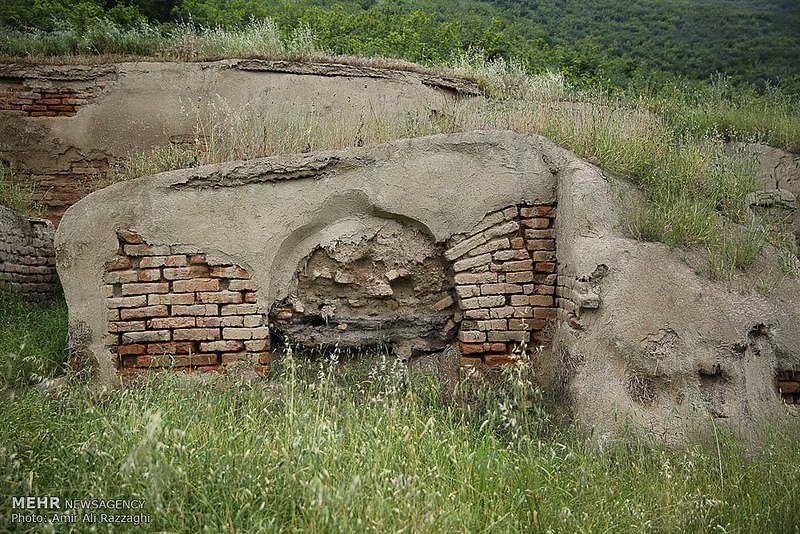The Great Wall
Once when the king went to tour his kingdom, he noticed that in the northern part, land was uncultivated and people were unhappy. On enquiring he was told that Turks and Huns from the North used to attack and loot people and hence they were scared to go out. The king immediately ordered a senior minister to have a series of huge defensive walls built around the place to protect the subjects against enemy tribes. The wall should start from the sea, be very high and must be made of lime and stone. Within a short time a wall was erected in the north-east along the Gurgan plains. Now, people lived fearlessly and the land started prospering.
These Persian Walls were similar to the Hadrian Wall of the Romans and the Great Wall of China. Four such walls were built, one in the north-east along the Gurgan plain, one in the north-west at the Caucasus passes, one in the south-east and one in south-west against the Arabs.

Military campaigns
The administrative and economic reforms of king Nosherwan reflected in his military success. In the west, he concluded a favourable treaty “The Eternal Peace” with Roman emperor Justinian in 535. The war with Armenia lasted a long time from 541 to 557 resulting in a truce. Between 557 and 558, he defeated the Hephthalites in the east. From 572 to 577 he checked the Turkic incursions into the north-east.
In 565, when Justin II became the Roman emperor, he started a war, which proved disastrous for him. By 573, he had lost parts of Caucasus, Mesopotamia and Syria. He appealed for peace and agreed to pay forty thousand gold coins. He also lost the fort of Dara to the Iranians. Soon after this humiliating defeat, Justin II lost his sanity.
The new emperor Tiberius in 578 continued the wars with Sasanians at Armenia with mixed fortunes. The Roman general Maurice kept on the fighting and later attempted to engage in peace negotiations, but in the same year the Iranian king passed away.
King Munzer of Arbastan
The Shahnameh tells us about the time when king Nosherwan went to Madayan. On the way, he saw a huge army from a distance. The commander of the army came to the king, introduced himself as king Munzer from Arbastan, and told him that though he had accepted his sovereignty, the Roman Caesar had attacked him. The king was very angry. He sent a messenger to the Caesar to inform him that Munzer was under his protection and he will not tolerate if he was attacked or harmed him in any way. The Caesar rebuked the messenger and replied that he would continue attacking Arbastan.
When the messenger informed Nosherwan of the Caesar’s reply, he decided to teach him a lesson. He selected a hundred thousand of his best soldiers, gave them to Munzer and asked him to take them along with his army and attack Rome.
Nosherwan sent a letter to the Caesar in which he told him that if he did not respect their treaty and attacked the countries under him, he will have no recourse but to retaliate. The Caesar replied that he was not under him and was free to do what he wanted. He reminded him how Alexander the Macedonian had destroyed Iran in the past. The Caesar further said that he was just settling scores with the Arabs who had looted Rome in the past.
When the messenger returned to the king, he pondered over the rebellious reply of the Caesar, consulted his ministers for three days and then decided to attack the Romans. With a huge army, he proceeded towards Rome. On the way he offered prayers and paid respect to the sacred fire of Adar Goshasp at the Azar Abadagan fire temple. He appointed Shiroy son of Behram as the Commander of the army and allotted different sections of the army to commanders Farhad, Ustad (son of Barzin), Gushasp, Mehran, and Hormazd (son of Kharrad). He strictly instructed his soldiers not to harass or loot civilians, nor destroy their properties or harm their fields.
Nosherwan proceeded towards Rome conquering on the way, the forts of Shurāb and Arāyesh. Just then, he got the news that the Caesar had sent an army under commander Beliserius to meet his army, and it was on its way. In the battle that ensued, the Roman army was defeated and its commander had to flee. On the way, Nosherwan captured the fort of Kalinius. From there he proceeded to Antioch. He was very much impressed with its beauty and did not attack it. Nearby he established a beautiful city and called it Zibe-Nosherwan. In this city he rehabilitated the Roman prisoners of war. He gave the reigns of this city to a local Christian and asked him to take care of it. The triumphant king then returned to Iran.
When the Caesar came to know of the might of Nosherwan’s army, he had second thoughts about going to war with him. He conferred with the elders of his empire who advised him not to fight against the Iranian king. He sent a delegation of sixty wise men, under the leadership of Mihraz to Nosherwan, apologised for challenging him and sent him a lot of treasure and taxes. The Iranian king accepted the gifts and the apology and demanded such taxes every year, along with the assurance that he will not go near Yaman and Arbastan.
King Nosherwan had a Christian queen, who had a son named Nushzad. The king was disappointed as the son had Christian leanings. Before leaving for Rome, he had kept him under house arrest at Shahpur-gard far away from the capital, as he was concerned that the young prince may easily be instigated and misled.
After an elated yet exhausted Nosherwan returned to Iran, he needed time to rest and recuperate. Hence he did not meet anybody, which gave rise to the rumour that the king had died on the way. When this rumour reached Nushzad, he fled from the house arrest after taking money from his mother. He then collected a thirty thousand strong army and started attacking and capturing Iranian provinces.
He wrote a letter to the Kaisar, to whom he was related, saying that he was fortunate that his father Nosherwan had died. Claiming to belong to the same race and religion as the Kaisar, he not only offered him his loyalty, but also the whole country of Iran, and called himself a vassal of the Kaisar.
Ram-barzin, the elderly ruler of Madayan got a whiff of this letter and informed the king, who was very much pained at his son’s behaviour, since he dearly loved him. He wrote a letter to Ram-barzin asking him to put an end to Nushzad’s activities and preferably take him prisoner. If he resisted, they should take him captive by force, but care should be taken that he should be kept with care and dignity in his own palace.
On receiving the letter, Rambarzin prepared to attack. When Nushzad came to know of this, he prepared his army under the command of Shamsās. A large part of his army comprised of Romans including Christian priests. The Roman commander tried to persuade Nushzad against fighting his own father and asked him to seek forgiveness. The arrogant Nushzad flatly refused to apologise and initiated the battle, in which he lost his life. Before dying he expressed the desire to be buried in a coffin like a Christian at the hands of his mother. His heavily injured body, ridden with arrows was taken to her mother, where the distraught queen received it with an extremely heavy heart. The entire city of Junde-Shahpur joined the king and the queen in their grief.(End of Part 2….to be continued)

Beautiful
Sent from Yahoo Mail for iPhone
LikeLike